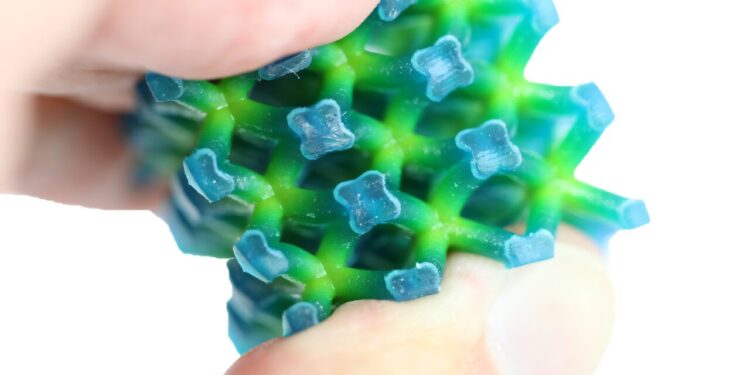A graduated trellis with flexible and rigid parts. Researchers at the University of Colorado Boulder have developed a new open source tool that allows engineers to more efficiently design multi-material 3D printed objects like this one. Credit: University of Colorado Boulder
A new open source tool is reshaping the way engineers design multi-material objects. Charles Wade, a Ph.D. student in the Department of Computer Science at the University of Colorado Boulder, created a design system software package that uses functions and code to map not only shapes, but also where different materials fit within a 3D object.
The project, called OpenVCAD, was developed in the Matter Assembly Computation Lab led by Assistant Professor Robert MacCurdy of the Paul M. Rady Department of Mechanical Engineering.
A new article, published in the journal Additive manufacturinghighlights the design tool and its potential to transform 3D printing by enabling engineers to design multi-material objects more efficiently.
“There is certainly a history of multi-material design studies and practices that existed long before OpenVCAD,” said MacCurdy, who is also affiliated with Computer Science and the Department of Electrical, Computer and Energy Engineering. “But we think the overhead of writing specific code for specific projects keeps engineers from doing as much design as they could every time.
“With OpenVCAD, we do all of this work at once – and we do it very well – so that users have an integrated infrastructure for representing these spatially variable, multi-material designs.”
A three-component degraded Utah teapot. Researchers at the University of Colorado Boulder have developed a new open source tool that allows engineers to more efficiently design multi-material 3D printed objects like this one. Credit: University of Colorado Boulder
Pushing the boundaries of multi-material design
Designing objects with multiple materials has long pushed the boundaries of conventional computer-aided design (CAD) software.
According to Wade and MacCurdy, traditional design tools tend to represent objects only as boundary surfaces. This means that they operate with the implicit assumption that everything inside a boundary surface is made of the same material.
One of the main areas of interest in mechanics is what is called gradient design, in which two materials are gradually mixed, one into the other, like a shoe sole that changes from firm at the bottom to soft at the top. But without a powerful design tool, translating difficult steps into smooth transitions can be extremely difficult.
This is why Wade developed OpenVCAD. The software package acts almost as a set of handy tools that allow users to not only easily compose complex functions, but also assign them as materials to objects in a 3D printer.
“This is the first code-based, multi-material design tool that is widely available,” Wade said. “It allows for good complexity when printing objects, it is accessible and intuitive to write and design. Unlike traditional CAD software, where you are forced to draw everything for each change and cannot represent graded materials, our tool allows users to change a small variable and look at the whole design updated in a simple way.”
A broad impact for all to explore
The team’s new paper explores OpenVCAD’s capabilities on a variety of 3D printers, including one available to MacCurdy’s lab group that allows printing of objects with up to five materials at a time.
However, it’s the project’s potential impact on the broader engineering community that excites them.
According to MacCurdy and his team, OpenVCAD software can be used to help researchers design objects relevant to almost any industry and any field.
A medical model scanned to print. Researchers at the University of Colorado Boulder have developed a new open source tool that allows engineers to more efficiently design multi-material 3D printed objects like this one. Credit: University of Colorado Boulder
Surgeons who need realistic planning models to train on can take advantage of the tool’s gradient blending properties. Soft robotics experts can use it to create flexible actuators that bend in one direction but remain straight and rigid in another. Engineers who need to simulate complex multi-material objects can design in OpenVCAD and easily export a simulation-ready file.
OpenVCAD can even apply specific mechanical properties to specific parts of truss structures, which are often used for their shock absorption capabilities to achieve more complex designs.
“We can build on the core capabilities of OpenVCAD to represent multi-material objects in many different domains,” MacCurdy said. “But there’s a lot more to come in some areas that we’re excited about and we really hope this approach to multi-material design takes off.”
OpenVCAD is a completely open source tool, which means it is widely available to engineers around the world. It’s even equipped with a Python implementation so any user can easily import the team’s repository and get to work with just one line of code.
“We want this to be widely available to the public,” Wade said. “We have a growing base of external researchers from other institutions who are using this tool and we hope to enable this community to do their best work.”
More information:
Implicit toolpath generation for functionally graded additive manufacturing via gradient-based slicing, Additive manufacturing (2025). DOI: 10.1016/j.addma.2025.104963
Provided by University of Colorado Boulder
Quote: Open source software enables efficient 3D printing with multiple materials (2025, October 13) retrieved October 13, 2025 from
This document is subject to copyright. Except for fair use for private study or research purposes, no part may be reproduced without written permission. The content is provided for informational purposes only.



